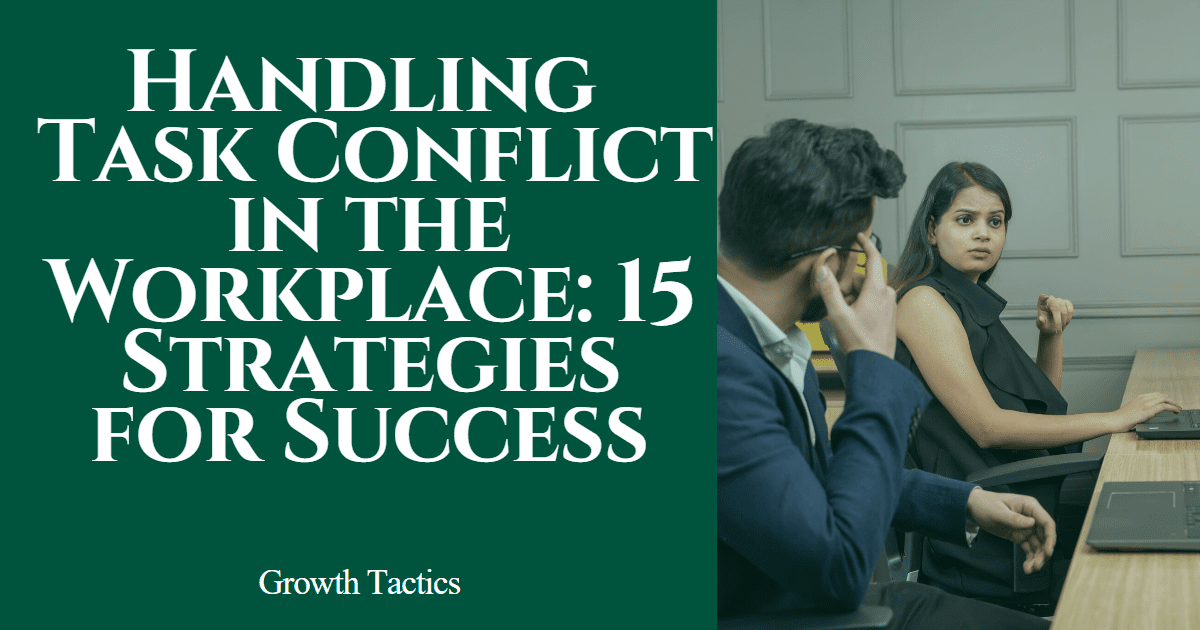Conflict is a natural part of human interaction, and in the workplace, it can arise from a variety of sources. One type of conflict that often occurs is task conflict, which refers to disagreements and differences of opinion regarding the completion of work tasks and goals.
While task conflict can be challenging to navigate, it is important to address and manage it effectively to ensure a productive and harmonious work environment. In this blog post, we will explore strategies for handling task conflict in the workplace, providing valuable insights and actionable tips for success.
Jump To Section
Understanding Task Conflict
Before getting into the strategies for handling task conflict, it is essential to gain a clear understanding of what task conflict entails. Task conflict refers to disagreements related to work tasks, objectives, and goals. It is important to note that task conflict is distinct from other types of conflict, such as relationship conflict or value conflict. Task conflict focuses solely on the work at hand and does not involve personal attacks or differences in core values.
Examples of Task Conflict
To better grasp the concept of task conflict, let’s explore a few examples.
Difference in Approaches
One scenario could involve team members having differing opinions on the best approach to complete a project. For example, while some team members may prefer a more conservative and cautious approach, others may prefer a more innovative and risk-taking approach. This difference in approaches can lead to disagreements and conflict regarding the best way to move forward.
Resource Allocation
Another example could be a disagreement about the allocation of resources for a particular task. For instance, if there is a limited budget or a shortage of personnel, team members may have conflicting opinions on how to prioritize and distribute resources. This can create tension and conflict as individuals advocate for their preferred allocation methods.
Diverse Problem-Solving Styles
Task conflict can also be observed when team members have different ways of thinking or problem-solving skills. For instance, some individuals may prefer to approach problems analytically and rely on data and evidence, while others may rely more on intuition and personal experience. These differing problem-solving styles can lead to clashes and disagreements when determining the best solution for a task or project.
By understanding these examples, we can identify common situations where task conflict may arise. Recognizing these scenarios can help us proactively address and manage task conflict in the workplace.
The Impact of Task Conflict
While some may see conflict as detrimental to team performance, research has shown that task conflict can actually have a positive effect when managed effectively. Task conflict, which involves disagreements and differences of opinion regarding work tasks and goals, can lead to improved team performance and productivity if handled properly.
Positive Effects of Task Conflict
-
Enhanced Creativity and Innovation: Task conflict encourages the exploration of different perspectives, ideas, and solutions. When team members engage in healthy debate and challenge each other’s viewpoints, it can foster the development of innovative ideas and approaches. By considering multiple perspectives, teams can find more creative solutions to problems.
-
Critical Evaluation and Quality Improvement: Task conflict prompts team members to critically evaluate their own ideas and proposals. Through constructive criticism and disagreement, teams can identify weaknesses, refine their strategies, and enhance the quality of their work. Task conflict drives teams to strive for higher standards and continuous improvement.
-
Increased engagement and motivation: When team members feel that their opinions are valued and that their contributions are considered, it can boost their engagement and motivation. Task conflict provides an opportunity for individuals to voice their ideas, concerns, and expertise. When team members feel heard and respected, they are more likely to be invested in the team’s goals and perform at their best.
Negative Effects of Unresolved Task Conflict
While task conflict can have positive outcomes, it is essential to recognize that unaddressed or mismanaged task conflict can lead to negative consequences. Here are some potential negative effects of unresolved task conflict:
-
Relationship Conflict: When task conflict escalates and becomes personal, it can spill over into relationship conflict. Personal animosity, hostility, and tension can develop between team members, impairing communication, collaboration, and teamwork. Relationship conflict negatively impacts trust and cooperation within the team.
-
Decreased Morale and Job Satisfaction: Persistent task conflict can create a negative work environment, leading to decreased morale and job satisfaction. When team members constantly face disagreements and conflicts, it can erode their enthusiasm, motivation, and overall satisfaction with their work. This can manifest in decreased productivity and higher employee turnover.
-
Stifled Innovation and Creativity: If task conflict remains unresolved or is suppressed, it can stifle innovation and creativity within the team. When diverse perspectives and ideas are not encouraged or considered, it can result in missed opportunities for breakthrough solutions and growth. Team members may become hesitant to speak up or share their ideas, fearing conflict or potential negative consequences.
Strategies for Handling Task Conflict
Now that we have established the significance of task conflict and its potential impact, let’s explore some strategies for task conflict resolution. These strategies will help foster open communication, encourage collaboration, and promote a healthy work environment.
1. Identify and Address the Conflict
The first step in handling task conflict is to identify its presence. This can be done by actively listening to team members, understanding their perspectives, and recognizing disagreements or differing opinions. By acknowledging the conflict early on, you can prevent it from escalating further and address it promptly.
2. Promote Open Communication
Open communication is crucial in resolving task conflict. Encourage team members to express their opinions, share their concerns, and contribute to the discussion openly. Foster an environment where everyone feels comfortable speaking up and sharing their thoughts. This will create an atmosphere of trust and collaboration.
3. Facilitate Collaborative Problem-Solving
To effectively handle task conflict, it is important to involve all parties in the conflict in finding a solution. Facilitate a collaborative problem-solving process where team members work together to develop solutions that meet the goals or objectives of the task. This approach encourages teamwork and creativity, emphasizing the importance of a collective effort rather than individual outcomes.
4. Focus on Concrete Issues and Facts
When addressing task conflict, it is crucial to focus on the specific issues at hand rather than personal differences or personality clashes. Encourage team members to approach the conflict from an objective standpoint and base their arguments on concrete facts and evidence. By keeping the discussion centered on the task at hand, you can prevent the conflict from becoming personal.
5. Develop Conflict-Resolution Skills
To effectively handle task conflict, it is essential to develop conflict-resolution skills among team members. Provide training or workshops focused on conflict management, active listening, and problem-solving. Equip your team with the necessary skills to address and resolve conflicts in a healthy and constructive manner.
6. Foster a Culture of Healthy Debate
Create an organizational culture that encourages healthy conflict and debate. Emphasize the importance of differing opinions and diverse perspectives in driving innovation and growth. When team members understand that conflict is an important part of the decision-making process, they are more likely to embrace task conflict and engage in constructive discussions.
7. Seek Mediation if Necessary
If the task conflict persists despite your efforts to address it internally, consider seeking mediation from a neutral third party. This person can help facilitate dialogue, guide the team towards resolution, and provide an unbiased perspective. Mediation can be particularly helpful if the conflict involves multiple team members or if there is a power imbalance within the team.
8. Learn from the Conflict
Every conflict provides an opportunity for growth and learning. Encourage team members to reflect on the task conflict and identify lessons that can be applied to future situations. By analyzing the conflict and its resolution, you can continuously improve your conflict-resolution strategies and prevent similar conflicts from arising in the future.
9. Set Clear Expectations and Goals
Clear expectations and goals can help prevent task conflicts from arising in the first place. Ensure that team members have a clear understanding of their roles, responsibilities, and the overall objectives of the task. Clearly communicate deadlines, deliverables, and any other important details. When everyone is on the same page, it minimizes the potential for misunderstandings and conflicts.
10. Encourage Active Listening
Active listening is a crucial skill in managing task conflict effectively. Encourage team members to listen attentively to each other without interrupting or jumping to conclusions. This helps create an atmosphere of respect and understanding. Encourage team members to paraphrase and summarize what has been said to ensure clarity and to show that they value the speaker’s perspective.
11. Encourage Constructive Feedback
Feedback plays a vital role in addressing and resolving task conflicts. Encourage team members to provide constructive feedback to each other in a respectful and specific manner. This feedback should focus on the issue at hand and not attack the person. When team members are open to receiving feedback and willing to make necessary adjustments, it can help resolve conflicts more effectively.
12. Use a Problem-Solving Framework
Using a problem-solving framework, such as the “5 Whys” or the “Fishbone Diagram,” can help identify the root causes of task conflicts. By digging deeper and understanding the underlying factors contributing to the conflict, you can develop more targeted and effective solutions. These frameworks can provide a structured approach to problem-solving and help facilitate productive discussions.
13. Encourage Compromise and Flexibility
In some cases, finding a middle ground or compromise may be necessary to resolve task conflicts. Encourage team members to be flexible and open to different perspectives and solutions. The ability to find common ground and make trade-offs can help reach resolutions that satisfy everyone’s needs and move the task forward.
14. Monitor and Manage Emotional Responses
Task conflicts can sometimes elicit emotional responses from team members. It’s important to address and manage these emotions constructively. Encourage team members to express their emotions respectfully and provide a safe space for them to do so. Being aware of and acknowledging these emotions can help prevent conflicts from escalating further and pave the way for more productive discussions.
15. Celebrate Successes and Achievements
Recognize and celebrate successes and achievements within the team. Focusing on positive outcomes helps build morale and strengthens team cohesion. By acknowledging and appreciating each team member’s contributions, it creates a positive environment that fosters collaboration and reduces the likelihood of conflicts arising.
Conclusion
Task conflict is a natural part of the workplace environment, but when managed effectively, it can lead to positive outcomes such as increased innovation and team performance. By identifying and addressing task conflict promptly, promoting open communication, encouraging collaborative problem-solving, and fostering a culture of healthy debate, organizations can handle task conflict successfully. By implementing the strategies outlined in this blog post, you can create a work environment that acknowledges the value of task conflict and harnesses its potential for growth and improvement.








